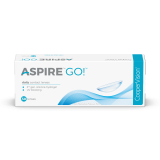
Considering Contact Lenses?
Getting your first pair of contact lenses can be very exciting, particularly if you’re one of more than 160 million Americans who currently wear glasses.1 While it’s true that both glasses and contact lenses can correct your vision, there are many reasons why people prefer contact lenses. For example, you might decide to start wearing contact lenses if glasses get in the way during fitness or sport activities. Glasses can also compete with fashion choices, whereas you will no longer need to match your outfits with your frames once you make the switch to contact lenses. Some people also need to carry several pair of glasses everywhere they go—a pair for seeing far, a pair for reading and a third pair of tinted sunglasses for outdoor activities. In short, your reasons to try contact lenses may be personal, but they are not frivolous. On the contrary, everyone deserves an opportunity to enjoy comfortable vision, so congratulations on your choice to take the next step.
As you’ll discover, making the decision to be less dependent on glasses is the first of many choices you’ll get to make when you choose contact lenses for vision correction. Although you may still need to wear glasses at times and you should always have a backup pair of glasses, today there are contact lenses that can help you see near and far most of the time—even if you have presbyopia or astigmatism.
Partnering with your doctor
The first and most important step in getting your first pair of contact lenses is to make an appointment with your eye doctor. Your eye care professional will perform a contact lens fitting evaluation. During a contact lens fitting, your eye care provider will assess the health of your ocular surface and take measurements of your eye’s unique shape to make sure the lenses fit properly and address your specific visual needs.
A contact lens fitter will have access to contact lenses that can meet a variety of visual needs, including near-sightedness, far-sightedness, and astigmatism. Contact lenses can even help correct for presbyopia, the age-related erosion of near vision that prompts us to reach for reading glasses.
Deciding what’s right for you
When you meet with your eye care provider, explain how you want to wear your new contact lenses. For example, you might want to wear them every day or only for special occasions, sports, and work. These are essential details that will help your doctor select an appropriate lens material and lens-wearing schedule, also known as a replacement schedule.
Improper cleaning and irregular replacement of contact lenses and contact lens cases—as well as other behaviors relating to contact lens hygiene and care—have been linked to a higher risk of complications,23 so you must always follow your doctors lens care advice, using specific cleaners and solutions. Never wash your lenses in water.
Never give into the temptation to take shortcuts or to extend the life of your lenses. If you think rubbing and rinsing contact lenses every night is too much hassle, talk to your doctor about a daily disposable lens. With daily disposable lenses, you start with a fresh new pair every day. At night, you simply throw them away. In fact, patients who wear daily disposable lenses are the most compliant with lens replacement.
Today, you can even get daily disposable lenses in silicone hydrogel materials, which are known to have high oxygen transmissibility, resulting in whiter looking eyes. This is one of many reasons why 92% of eye care practitioners agree that silicone hydrogel 1 day lenses are the best choice to safeguard their patients' eye heath related to contact lens wear.4
CooperVision offers two brands of silicone hydrogel daily disposable lenses: clariti® 1 day and MyDay® 1 day. To learn more, talk to your doctor.
1 VisionWatch – The Vision Council Member Benefit Report, September, 2016
2 Dumbleton KA, Woods CA, Jones LW, Fonn D. The relationship between compliance with lens replacement and contact lens-related problems in silicone hydrogel wearers. External Cont Lens Anterior Eye. 2011;34(5):216-22.
3 Stapleton F, Edwards K, Keay L, Naduvilath T, Dart JK, Brian G, Holden B. Risk factors for moderate and severe microbial keratitis in daily wear contact lens users. External Ophthalmology. 2012;119(8):1516-21
4 G. Orsborn and K. Dumbleton: Eye care professionals’ perceptions of the benefits of daily disposable silicone hydrogel contact lenses. Contact Lens and Anterior Eye. February 2019.






